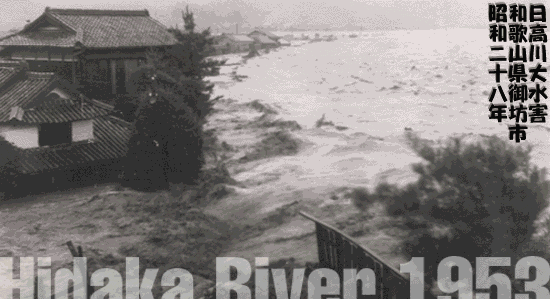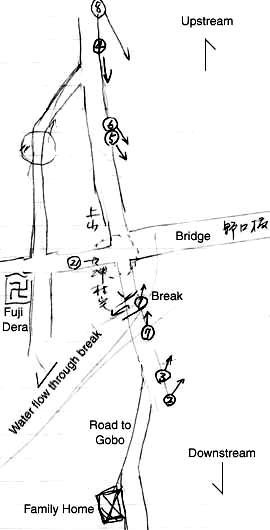
|
On July 18, 1953, heavy rains in the mountains behind Gobo City pushed the Hidaka River up and over its banks, flooding the lower river valley and the city, and destroying scores of homes and bridges. Yoko's parents lived just a few dozen meters downstream from the levee break seen above (looking upstream). Their house sat on a very slight rise so most of the water flowed around the back of the house and into the low-lying flood plain, essentially leaving them with a wet floor but very little damage. A few miles downstream, Gobo City knew nothing of the events upstream. In those days, there was no emergency warning system, few televisions and fewer telephones. They knew about the rains, and they could see the water rising in the river, but they had no idea of the water that was heading their way through the flood plain. Yoko's mother evacuated the family home with Michio -- a baby at the time -- just before the break and made it to her parent's home in the city in time to warn them. They managed to put most of the goods on the first floor upstairs before the waters began rising in the streets outside. They also managed to cook some food which they shared with less fortunage neighbors via second-story windows and rooftops. The following pictures were taken by a friend of Yoko's father. The map, drawn by Yoko's mother, is a numbered key to the photos and the directions in which they were taken. |
 |
| 1. The waters are just below the wooden bridge and everyone has come out to gawk. | |
| 3. These two fellows, their brains addled by sake (rice wine) took a foolhardy stroll across the bridge. | |
| 5. Twenty minutes later, debris from a washed out home strikes... | |
|
9. ...and rips a hole in the bridge right where those drunken fools were walking. They nearly qualified for the 1953 Darwin Awards*, given to those who voluntarily take themselves out of the gene pool. |
|
| 7. The water is now so high that it comes OVER the bridge and threatens to pour through the gap in the retaining wall. Neighbors struggle to plug the gap. They'll win this battle but lose the war when the water eventually breaks through just downstream of the bridge. | |
| 8. It is only a matter of time now. No one is outside except the family friend, still taking pictures. | |
| 10. The water breaks through and begins its destructive journey towards downtown Gobo. | |
| 12. Another break in the levee. |
|
| 13. The water is approaching the eaves of these homes and shops behind the family home, forcing their occupants onto the roofs (on the house to the right). In the distance, just under the tallest utility pole, is Fuji Dera, the family temple. | |
| 15. The area around the family's home was literally wiped clean. Yoko's mother said that it was worse than an earthquake or a fire because those events always leave some visible remnants, if only ashes. But the flood of 1953 left nothing behind but mud. | |
| 32. Near where the Senjyuudo market now stands was this school, a refuge during the high waters. | |
| 35. As you can see in this picture and in the one above, boats were the main form of transportation during the flood. | |
| 46. Downstream, the main bridge was also wiped out, as was a good portion of the settlement along the banks. | |